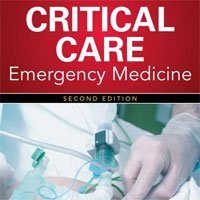Tag: ventilation
Promoting Evidence-Based Practice in ARDS
There is a dearth of literature addressing interventions to improve implementation of evidence-based practices in acute respiratory distress syndrome (ARDS). Existing interventions to improve clinician knowledge and facilitate... read more
Remestemcel-L reduces ARDS mortality in those under 65 years old
New data shows patients with COVID-19-related Acute Respiratory Distress Syndrome (ARDS) were up to 75 percent less likely to die when treated with remestemcel-L and dexamethasone. The data shows remestemcel-L reduced... read more
Prone Positioning in Spontaneously Breathing Subjects With Moderate or Severe ARDS During Invasive Ventilation
In a retrospective analysis of consecutive intubated subjects with moderate or severe ARDS, related or not to COVID-19, spontaneous breathing during prone positioning (PP) was well tolerated and achieved significant improvement... read more
Critical Care Emergency Medicine
The groundbreaking text on critical care emergency medicine – updated with the latest evidence and recommendations. Critical Care Emergency Medicine has become the standard reference for all clinicians who wish to understand... read more

Prone Positioning of Nonintubated Patients with COVID-19
Despite the significant variability in frequency and duration of prone positioning and respiratory supports applied, prone positioning was associated with improvement in oxygenation variables without any reported serious... read more
Expiratory Flow Limitation During Mechanical Ventilation
Expiratory flow limitation (EFL) is present when the flow cannot rise despite an increase in the expiratory driving pressure. The mechanisms of EFL are debated but are believed to be related to the collapsibility of small... read more
Assess the Intensity of Inspiratory Efforts Using CVP Waveforms
Real case: You are passing by the room of an awake mechanically ventilated patient with advanced IPF. Peeking in from outside the room, the following CVP waveform catches your attention. In a recent post, we discussed... read more
Comparison of the Efficacy and Safety of Cuffed vs. Uncuffed Endotracheal Tubes for Infants in the Intensive Care
There was no difference in the primary outcome, though percentage time spent in optimal leak range was significantly higher in cuffed uncuffed endotracheal tube (ETT) group. Cuffed ETTs reduced reintubations to optimise ETT... read more
90 Day Outcomes of COVID-19 Patients in European ICUs
This communication delineates outcomes in COVID-19 patients in the context of ARDS severity, ventilatory management, and variables associated with mortality on a 90-day follow-up for subgroups of patients after ICU admission.... read more
Co-infection in Critically Ill Patients with COVID-19
During previous viral pandemics, reported co-infection rates and implicated pathogens have varied. In the 1918 influenza pandemic, a large proportion of severe illness and death was complicated by bacterial co-infection,... read more
Individualized vs. Fixed Positive End-expiratory Pressure for Intraoperative Mechanical Ventilation in Obese Patients
This secondary analysis of obese patients undergoing laparoscopic surgery found better oxygenation, lower driving pressures, and redistribution of ventilation toward dependent lung areas measured by electrical impedance tomography... read more
COVID-19: Critical Care and Airway Management Issues
Among patients hospitalized with coronavirus disease 2019 (COVID-19), up to one-quarter require intensive care unit (ICU) admission. Profound hypoxemic respiratory failure from acute respiratory distress syndrome (ARDS)... read more
Operative Lung Deflation During OLV with a DL-ETT
Operative lung deflation during lung deflation during one-lung ventilation (OLV) with a double-lumen endotracheal tube (DL-ETT) is faster when the operative lumen remains closed before pleural opening thus preventing it from... read more
Prone Position in Intubated, Mechanically Ventilated COVID-19 Patients
During the COVID-19 pandemic, prone position has been widely adopted to treat mechanically ventilated patients with respiratory failure. The majority of patients improved their oxygenation during prone position, most likely... read more
Effects of Ventilatory Rescue Therapies on the Cerebral Oxygenation of COVID-19 Patients
A new study by Masimo published in Critical Care evaluated the impact of a variety of rescue therapies on the systemic and cerebral oxygenation of mechanically ventilated COVID-19 patients suffering from acute respiratory... read more
24-Hour Esophageal pH Measurement in Mechanically Ventilated Children
The current study shows high incidence of gastroesophageal reflux on 24-hour esophageal pH-metry in mechanically ventilated children with medical diagnoses. The significance of this finding and its impact on ventilator-associated... read more
Effect of Helmet Noninvasive Ventilation vs. High-Flow Nasal Oxygen in Patients with COVID-19
Among patients with COVID-19 and moderate to severe hypoxemia, treatment with helmet noninvasive ventilation, compared with high-flow nasal oxygen, resulted in no significant difference in the number of days free of respiratory... read more
Early Tracheotomy Shortens ICU Stay and Lowers Risk of VAP
Compared with late tracheotomy, early intervention was associated with lower ventilator-associated pneumonia (VAP) rates and shorter durations of mechanical ventilation and ICU stay, but not with reduced short-term, all-cause... read more
Ventilator Weaning and Discontinuation Practices for Critically Ill Patients
In this observational study of invasive mechanical ventilation discontinuation in 142 ICUs in Canada, India, the UK, Europe, Australia/New Zealand, and the US from 2013 to 2016, weaning practices varied internationally. Among... read more
The Influence of Airflow Via High-Flow Nasal Cannula on Duration of Laryngeal Vestibule Closure
The purpose of this experimental study was to investigate the influence of airflow via high-flow nasal cannula (HFNC) on the duration of laryngeal vestibule closure (dLVC) and Penetration-Aspiration Scale (PAS) scores. 29... read more
Timing of Intubation in Patients With COVID-19
The timing of intubation in hypoxemic patients with COVID-19 has been hotly debated. Early in the pandemic, there was a push to intubate early, driven by the effort to reduce transmission of the virus. With time, high-flow... read more
Body Mass Index and Risk for COVID-19
Obesity* is a recognized risk factor for severe COVID-19, possibly related to chronic inflammation that disrupts immune and thrombogenic responses to pathogens as well as to impaired lung function from excess weight. Obesity... read more









